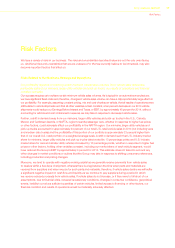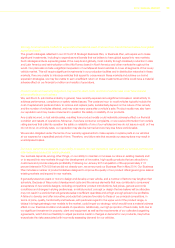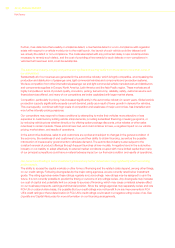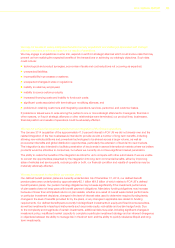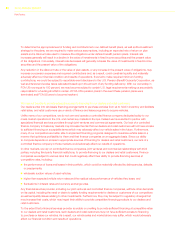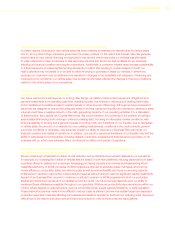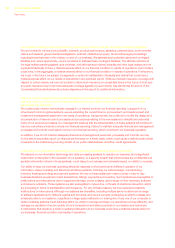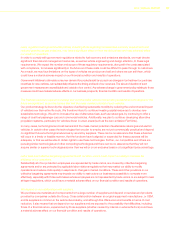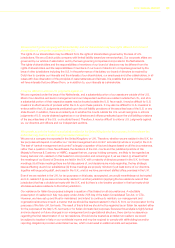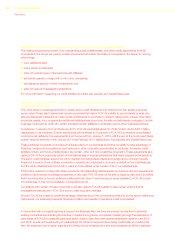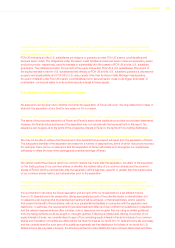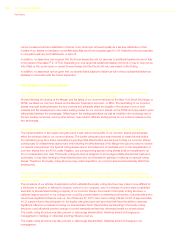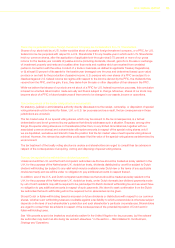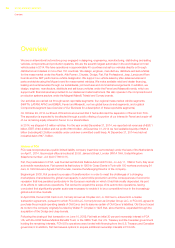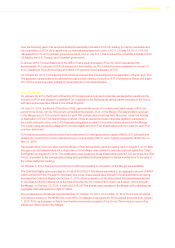Chrysler 2014 Annual Report Download - page 29
Download and view the complete annual report
Please find page 29 of the 2014 Chrysler annual report below. You can navigate through the pages in the report by either clicking on the pages listed below, or by using the keyword search tool below to find specific information within the annual report.
2014 | ANNUAL REPORT 27
Laws, regulations and governmental policies, including those regarding increased fuel economy requirements and
reduced greenhouse gas emissions, may have a significant effect on how we do business and may adversely affect
our results of operations.
In order to comply with government regulations related to fuel economy and emissions standards, we must devote
significant financial and management resources, as well as vehicle engineering and design attention, to these legal
requirements. We expect the number and scope of these regulatory requirements, along with the costs associated
with compliance, to increase significantly in the future and these costs could be difficult to pass through to customers.
As a result, we may face limitations on the types of vehicles we produce and sell and where we can sell them, which
could have a material adverse impact on our financial condition and results of operations.
Government initiatives to stimulate consumer demand for products sold by us, such as changes in tax treatment or purchase
incentives for new vehicles, can substantially influence the timing and level of our revenues. The size and duration of such
government measures are unpredictable and outside of our control. Any adverse change in government policy relating to those
measures could have material adverse effects on our business prospects, financial condition and results of operations.
The financial resources required to develop and commercialize vehicles incorporating sustainable technologies for the
future are significant, as are the barriers that limit the mass-market potential of such vehicles.
Our product strategy is driven by the objective of achieving sustainable mobility by reducing the environmental impact
of vehicles over their entire life cycle. We therefore intend to continue investing capital resources to develop new
sustainable technology. We aim to increase the use of alternative fuels, such as natural gas, by continuing to offer a
range of dual-fuel passenger cars and commercial vehicles. Additionally, we plan to continue developing alternative
propulsion systems, particularly for vehicles driven in urban areas (such as the zero-emission Fiat 500e).
In many cases, technological and cost barriers limit the mass-market potential of sustainable natural gas and electric
vehicles. In certain other cases the technologies that we plan to employ are not yet commercially practical and depend
on significant future technological advances by us and by suppliers. There can be no assurance that these advances
will occur in a timely or feasible manner, that the funds we have budgeted or expended for these purposes will be
adequate, or that we will be able to obtain rights to use these technologies. Further, our competitors and others are
pursuing similar technologies and other competing technologies and there can be no assurance that they will not
acquire similar or superior technologies sooner than we will or on an exclusive basis or at a significant price advantage.
Labor laws and collective bargaining agreements with our labor unions could impact our ability to increase the
efficiency of our operations.
Substantially all of our production employees are represented by trade unions, are covered by collective bargaining
agreements and/or are protected by applicable labor relations regulations that may restrict our ability to modify
operations and reduce costs quickly in response to changes in market conditions. These and other provisions in our
collective bargaining agreements may impede our ability to restructure our business successfully to compete more
effectively, especially with those automakers whose employees are not represented by trade unions or are subject to less
stringent regulations, which could have a material adverse effect on our financial condition and results of operations.
We depend on our relationships with suppliers.
We purchase raw materials and components from a large number of suppliers and depend on services and products
provided by companies outside the Group. Close collaboration between an original equipment manufacturer, or OEM,
and its suppliers is common in the automotive industry, and although this offers economic benefits in terms of cost
reduction, it also means that we depend on our suppliers and are exposed to the possibility that difficulties, including
those of a financial nature, experienced by those suppliers (whether caused by internal or external factors) could have
a material adverse effect on our financial condition and results of operations.


